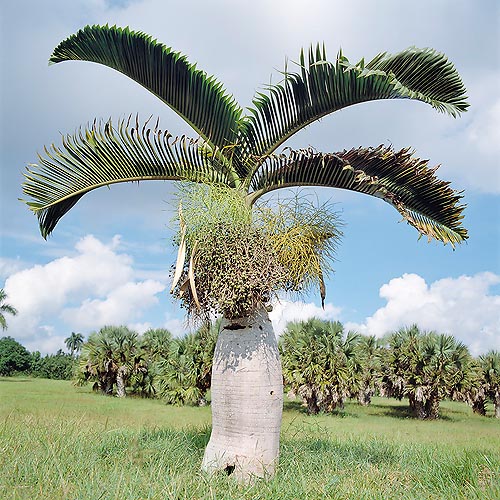Family : Arecaceae

Text © Pietro Puccio

English translation by Mario Beltramini

The odd Bottle palm may be 4 m tall and 70 cm broad © Giuseppe Mazza
The Hyophorbe lagenicaulis (L.H.Bailey) H.E.Moore (1976) is an endemic plant of an islet, the Ile Ronde (Mauritius), where it is at very high risk of extinction, as there are no more than 10 adult specimen alive; the spontaneous reproduction has recently increased thanks to the institution of a natural reserve.
It is known locally (Mauritius), as “palmier bonbonne”, elsewhere as “palma bottiglia” (Italian); “bottle palm”, “pig nut palm” (English); “palmier bouteille” (French); “Flaschenpalme” (German); “palmera botella”, “palma botella”, “mascarena” (Spanish); “palmeira-garrafa” (Portuguese).
It shows a solitary greyish trunk, on which are visible the rings left by the fallen-off leaves, with the typical shape of a bottle, tall up to 4 metres, with a diameter of 50-70
cm in the median part, much narrower, 10-30 cm of diameter, at the apex. The leaves, no more than 8, pinnate, are arched, about 2-3 m long, on a short petiole (10-15 cm of length). The leaflets are of a glossy dark green colour and are inserted on the rachis, to form a V, turned upwards.
The inflorescence, about 80 cm long and very ramified, develops under the leaves and carries cream coloured flowers of both sexes. The fruits are oblong, 2-3 cm long, of orange colour, turning to the black when ripe. It reproduces by seed, which takes 4-6 months to germinate. Slow-growth plant, is suitable only for tropical climates where it prefers sunny locations; when cultivated in pot, it has a limited utilization for indoor decoration.
Synonyms: Mascarena lagenicaulis L.H.Bailey (1942); Mascarena revaughanii L.H.Bailey (1942).
→ For general notions about ARECACEAE please click here.
